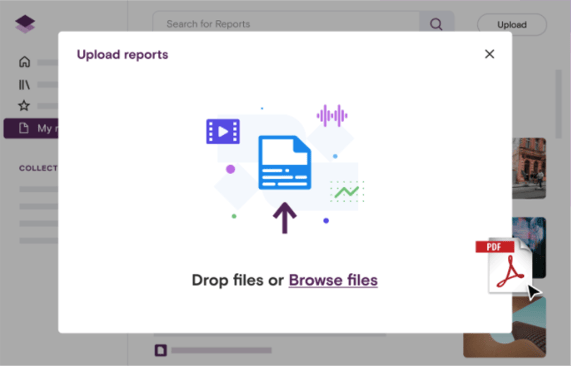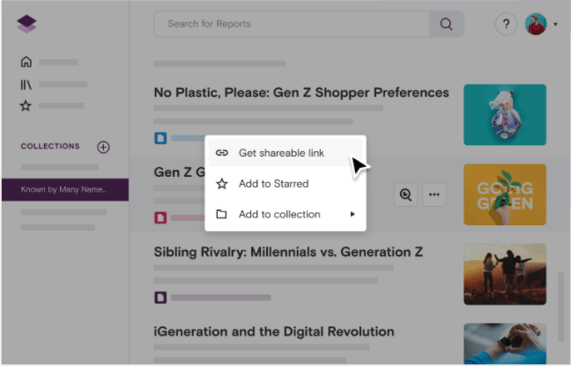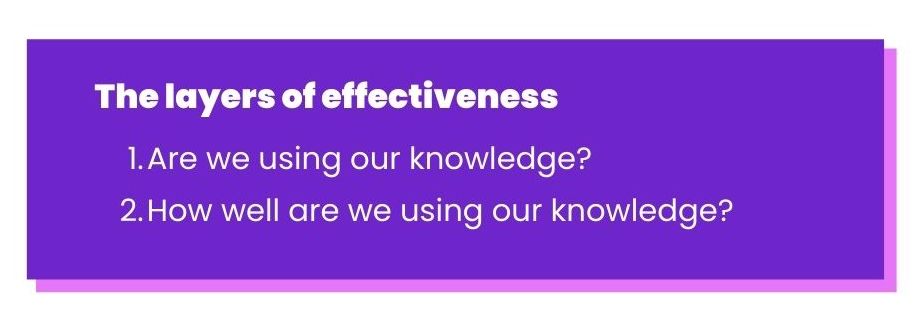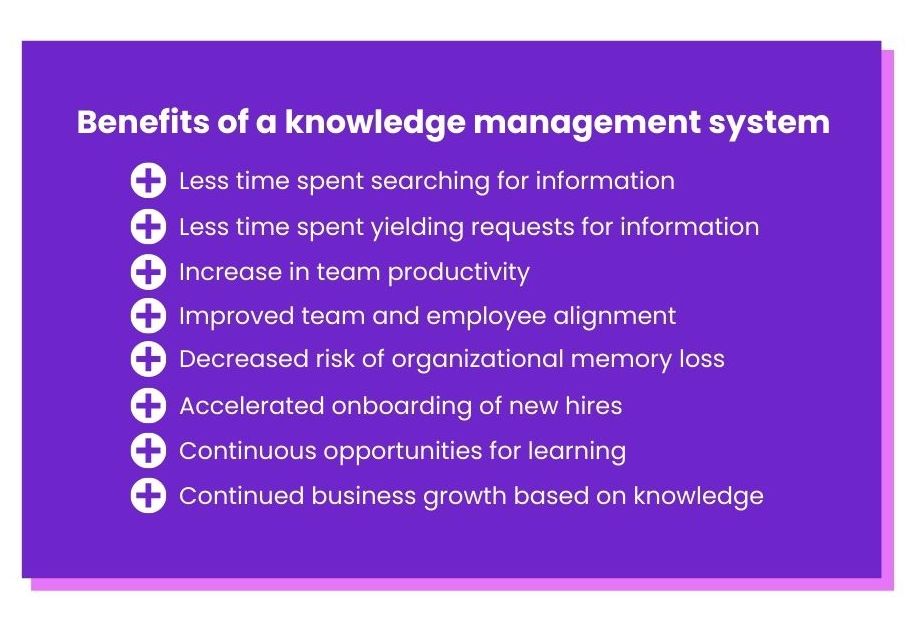Broadly speaking, the term knowledge management system refers to the general method(s) an organization or group uses to capture, distribute, and effectively use information.
In a business context, this term typically refers to an IT system, solution, or software. However, knowledge management systems can also include analogue practices like filing cabinets or conversations between employees in an organization. It’s common for companies to combine several different types of knowledge management systems at the same time.
For the purposes of this article, we’ll primarily focus on the different types of digital knowledge management systems, as these are the tools most commonly used by companies today. They also present the largest variety of solutions, which can make it especially challenging to select the right system(s) for your organization.
1. Is knowledge management the same as a knowledge management system? How are they different?
This is a great question. While sometimes people use these terms interchangeably, there are some subtle but important differences between them. In essence, knowledge management is the overarching goal, and a knowledge management system is the tool that supports and enables the activities necessary to achieve that goal. With that in mind, you should think of knowledge management systems as the specific method(s) used to carry out a broader knowledge management strategy.
Understanding this key difference between the two terms makes it a lot easier to communicate about them precisely, which makes it more simple to create a concrete plan.
1.1 Examples of digital knowledge management systems
As we’ve discussed above, the category of knowledge management systems can be quite broad. In order to help you gain a more clear understanding, let’s break it down a bit further and explore some examples of the different types of digital knowledge management systems.
Digital folder systems
Digital folder systems refer to the folder systems you can organize yourself on your desktop. While they are often localized, they can be connected to a shared server.
Cloud-based shared drives
This refers to systems like GoogleDrive or DropBox. Depending on the system, it might be storage-focused like DropBox, or it also might allow for document creation and editing like GoogleDrive.
Intranets
Intranets tend to be customized solutions run by an internal IT department. For example, they might be used as an employee directory or a place to store information on company policies.
SharePoint
SharePoint allows for the creation of internal websites and can act as a sort of intranet. These can be a good choice for general company knowledge.
Specialized knowledge management softwares
Specialized knowledge management softwares are used to manage a specific type of knowledge in order to achieve particular goals. For example, this might be a service knowledge management software like HubSpot or Zendesk, a digital asset management platform like Bynder, or a knowledge management software for market research and insights like Stravito.
2. Why is a knowledge management system important for a business?
A knowledge management system helps your business leverage your organization’s collective knowledge. Knowledge management systems solve a variety of challenges that modern businesses face, and the right one can actually help you to create new opportunities. They are a great way to break down knowledge silos and at the same time reduce the negative impacts of information overload.
Effective knowledge management is a prerequisite for business success, especially for specialized areas such as market research and consumer insights. That is because they at the very core were commissioned in order to be leveraged by the organization to make better, more well-informed decisions. This importance can be explained through the concept of consumer centricity.
Consumer centricity refers to the practice of making business decisions centered around the needs and wants of all consumers who could potentially purchase your product. It’s a business philosophy that focuses on why consumers are or aren’t buying your product, respecting the ephemeral identity of the customer for consumer-facing businesses. And as research has shown, it’s vital for business success.

Consumer centricity helps to guide and improve the innovation process, making it easier to apply jobs-to-be-done theory. And this improved innovation leads to increased growth. In fact, a study conducted by Watermark Consulting found that companies who concentrated their focus on customer experience benefitted from 183.3% cumulative total ROI over an 11 year period. This was compared with the S&P 500 Index of 138.7% cumulative ROI, and the worst-performing companies from a customer experience perspective falling far behind with a cumulative ROI of 63.1% over that same period.
However, achieving effective knowledge management and consumer centricity without the right technological support is nearly impossible. In the next section, we’ll provide an in-depth illustration of how companies can use a knowledge management system to support and enhance their day-to-day activities as well as their long-term business performance.
3. How do companies use a knowledge management system?
As we discussed in the introduction, knowledge management systems allow companies to capture, distribute, and effectively use knowledge, like for instance consumer market research. So let's use the same overarching categories to break down the different functionalities and applications of a knowledge management system.
To give you a richer picture, we’ll use Stravito as an example, illustrating how companies use it as a knowledge management system for their market research and insights.
3.1 Capturing knowledge
This is part of the knowledge management process where information is generated, packaged, and stored. How exactly that corresponds to a specific knowledge management system functionality depends on the type of research. Consumer insights teams and other similar functions often gather a wide variety of data and insights on consumer markets and their customers.
For example, research might be gathered to evaluate new ideas for products, test the effectiveness of messaging, assess competitor strategies, follow consumer behavior in real-time, or analyze macro trends for predictive purposes.
And then depending on the type of research, it might be packaged as a Powerpoint slide deck or pdf, saved as a video, or illustrated with a dashboard. A knowledge management system like Stravito uses advanced technology to centralize, categorize, and organize this information while reducing the manual workload for users.
In some cases, for example, Insights managers don’t need to do any additional work at all. Instead, a knowledge management system like Stravito automatically syncs with their Google Drive or centralizes links to external providers like Euromonitor or Mintel.
Or if they are working with an external partner, like a market research agency, the agency can upload the final report into a shared project hosted in the platform, allowing the Insights manager to publish the final report (and any other important files, like stimuli or surveys) directly into the shared platform. And of course, if an Insights manager wants or needs to upload a report themselves, for instance from an attachment in an email, they can easily drag and drop the relevant documents or files into the platform.

Whether files are uploading directly or indirectly, categorizing and organizing begins automatically the second the file reaches the platform. Customized AI and machine learning algorithms work quickly to extract essential information like title, year, country, or type of research. Additionally, the algorithms index the files in their entirety (including speech in videos), making them easily findable for employees, even if they can only remember a term that was mentioned somewhere in a report, but not the name of the report itself. And they also locate important pages like Key Findings and Target Group/Method. This lays the groundwork for use in the next stages of the knowledge management process, making it possible for users to find and access information that has been uploaded within seconds.
Now, let’s pause for a moment and evaluate how these activities might look without a dedicated knowledge management system like Stravito. Storing and centralizing research documents and sources becomes a manual task that needs to be performed by the employees themselves. This can be challenging, especially if the files are in different file formats (like pdfs and links to dashboards) or if different teams or even employees have their own ways of doing things. What’s a logical structure to one person, doesn’t necessarily correspond to what someone else calls logical. And as external partners are likely sending important files through email, where those messages have to compete with dozens (if not hundreds) of other emails everyday, it’s easy for files to get lost in the ether.
And then comes the additional challenge of categorizing. Depending on the system being used, this might be limited to the file name or only possible through manual tagging, which is time-consuming and often arbitrary. In order for files to be organized (and thus accessible), standardized file-naming conventions likely need to be remembered and adhered to, before files are manually added to their final destination in a shared drive or folder. The brunt of the workload is placed on employees, and in order for their actions to enable the rest of the activities in the knowledge management process, they need to be done correctly.
3.2 Distributing knowledge
Once knowledge has been captured, it’s ready to be distributed to relevant stakeholders in the organization. And depending on the size and structure of the organization, this can be quite a challenging feat.
Many organizations rely on their Consumer Insights function to ensure that market knowledge and insights are circulated effectively, reaching the right people. The problem with this is that it limits the potential of the Consumer Insights function, instead of leveraging them as strategic business partners or a source of competitive advantage. This means that time is taken away from valuable and necessary insights work, like research, analysis, interpretation, and forecasting.
A knowledge management system like Stravito greatly reduces the burden of distributing knowledge and insights that is often placed on Consumer Insights teams. It accomplishes this in two primary ways: by facilitating self-service access to insights for organizational stakeholders and by offering a variety of methods for knowledge sharing.

Let’s start with self-service access to insights. One of the forces that drives distribution is curiosity; internal stakeholders have a question, so they look for an answer. It’s a very practical motivation, and one that should be encouraged. But as we illustrated above, this often ends up with the Consumer Insights function being overwhelmed with requests for information. It’s also frequently the case that many people have the same questions or requests, over and over again. This happens for many reasons. For example, it might be in conjunction with repetitive processes, like onboarding of new hires, or it could be the result of knowledge silos that have accumulated internally.
But regardless of the origin, a dedicated knowledge management system like Stravito simplifies knowledge discovery for internal stakeholders, by creating the possibility of self-service access. On a basic level, this is a result of having a centralized repository for market research and insights. Stakeholders know exactly where to look when they have a question, saving time that would otherwise be spent searching through inboxes and shared drives, or asking the Consumer Insights team for directions or access to files.
In addition to this, the advanced search technology used by modern knowledge management systems such as Stravito, called Natural Language Processing, simplifies the search process once users are logged in the platform. It does this by understanding what users mean, not just what exact terms they type in. For example, if a user searches for “soda water trends”, NLP will enable Stravito to return results for “sparkling water trends” as well. This capability, along with the indexing capability we described when illustrating the Capturing phase of the knowledge management process, makes it easier for users to find what they’re looking for. Users no longer need to remember exact file names or phrases to access relevant insights to help them make better and more informed decisions.
So in an organizational context, a knowledge management system like Stravito uses advanced technology like AI, Machine Learning, and Natural Language Processing (NLP) search, to enable self-service access to research and insights. This greatly reduces one part of the workload required to distribute knowledge in an organization.
However, a powerful knowledge management strategy doesn’t just rely on individual curious stakeholders with one-off questions or ideas. Rather, it’s also actualized by systematically distributing relevant knowledge and insights to various groups of stakeholders throughout the organization. Without the right kind of support, this can create a substantial additional workload for the knowledge producing teams, which as you’ll recall, is something you want to avoid creating. A knowledge management system like Stravito allows you to streamline these activities by offering a variety of methods for insights distribution.
For example, you can generate a secure link to share a specific report via email or your messaging platform of choice. But you can also share links to Collections of reports (think of it like a group of documents with market research and insights). And beyond link sharing, users can choose to follow topics in the form of Collections in the platform so that they stay continuously up-to-date on the latest information about a given topic or area of interest. And if an insights manager feels that certain reports or Collections are relevant for the entire organization, they can promote them in the Home View of Stravito, so that the entire organization sees them automatically when they log in to the platform.
And of course, platform admins can adjust access permissions to files or Collections so that they are visible only to certain teams and individuals. This ensures that confidential or sensitive documents aren’t seen by people who shouldn’t see them, but it can also be a way to ensure relevant information doesn’t get lost in the shuffle.
Distributing knowledge, like market research and consumer insights, within an organization can quickly become a lot of work. Using a knowledge management system can help reduce the amount of manual effort required, while also providing more precision than you would get by relying on manual distribution efforts alone. This precision is what sets you up for success in the next stage of the knowledge management process: effectively using knowledge.
3.3 Effectively using knowledge
This phase is truly what it all comes down to; it’s the good stuff, the ultimate goal.
Because you don’t go through the first two phases with the intention of creating a museum full of insights artifacts, do you? No, exactly, of course you don’t. You do it because you want your entire organization to use knowledge to make better business decisions, to innovate, to create products and campaigns that speak to the evolving needs and wants of consumers, to uncover new research findings that completely change the game. That’s why you do it.
But how exactly do you do that? The answer lies in exploring what it actually means to use knowledge effectively, to sift through the various layers.
The first layer of effectiveness is achieved when the steps of the knowledge management process itself run smoothly; knowledge is being used. But beyond that, it’s essential to understand whether or not that knowledge is being applied in a way that makes an impact. In other words, you should ask yourself two questions:
A basic knowledge management system will allow you to answer yes to the first question, but an excellent knowledge management system will ensure that you can also answer the second.
For example, effectiveness might look like actually being able to find the research you commissioned and not wasting money on duplicate research. Because unused, lost, or forgotten knowledge cannot be used at all, making it ineffective by default. So on this level, it’s a binary measure; knowledge is used effectively when it is actually used. While this might seem obvious, it can be challenging for large, decentralized organizations to actually know what they know, especially if they don’t have a knowledge management system to support them in their efforts.
And then there is the question of how well knowledge is used. On this level, it’s about understanding how knowledge is applied to business decision-making and what impact these decisions have for the business. Because there is a disconnect between knowledge being distributed and knowledge being used. Receiving information and being able to access it does not automatically mean that we will use it.
We’re only human after all. And humans can still engage in biased decision-making even when presented with the research and insights. In our interview with Estrella Lopez-Brea from General Mills, she offered an illustrative anecdote (and likely one you can relate to) about a meeting where the results of a product test were being presented. The results of the study were far from positive, and one of her colleagues jumped in to challenge the results, saying “I disagree with this–I gave this product to my wife, and she loved it!” It’s that easy to slip up and project yourself onto the consumer you are targeting.
But beyond bias, sometimes information isn’t presented in a way that makes it easy to digest. Even if with the best intentions, we can’t possibly remember all of the important information that we are presented with during our work days. With countless emails to check, reports to skim, whitepapers to read, meetings to attend, webinars to view, and podcasts to listen to, it becomes a challenge to make sure that we don’t simply have the ability to access information, but that we retain it.
And this is where a knowledge management system like Stravito can be incredibly helpful. As we’ve already illustrated, it helps to solve the problems in this phase of the knowledge management process by accounting for the common challenges that arise in the first two phases. But a great knowledge management system can actually take it one step further, by making it easy and even fun to explore and consume knowledge and insights.
For example, as we mentioned before, you can skip straight to the good stuff. Stravito automatically extracts key information like Key Findings, Target Group, and Method. So when you’re searching for information, you don’t have to sift through the entire document to find the answers you’re looking for. Additionally, by offering editorialized, curated articles that create an overview of key topics, knowledge and insights can be packaged in an effective, engaging way. And because the platform is easy and even fun to use, it removes unnecessary friction or stress that would otherwise distract you from the work you’re trying to do.
4. The benefits of a knowledge management system
In the previous section, we examined how a knowledge management system for market research and consumer insights can benefit an organization.
While the specific benefits of a knowledge management system are largely dependent on the type of knowledge involved, there are some universal benefits.

5. How do companies justify a knowledge management system investment?
By now, you should have a much more clear understanding of a knowledge management system’s utility. You likely understand how a knowledge management system can solve common workplace challenges. But just how costly are these challenges?
To answer this question, we’ll continue with our example on market research and consumer insights.
Globally, over $80 billion USD is spent on research and insights every year, and that number continues to grow. Unfortunately, it’s very common for a significant part of that spend to go to waste. In fact, a survey conducted by Stravito found that 66% of businesses wasted money on unused market research in 2020. A knowledge management system can help to ensure that your company maximizes the value of the market research and consumer insights you purchase by making information easy to access. And as we discussed earlier, it can also prevent unnecessary spend on duplicate research, and ensure that employees make the best decisions they can based on the organization’s collective knowledge.
Another reason to consider investing in a knowledge management system is the value of employee time. In fact, in the U.S. economy alone, analysis has suggested that information overload costs over $900 billion in lost productivity and innovation.
But let’s look at what those numbers might look like for an individual company. The median salary for a consumer insights manager in the US is $122,000/year. Now consider that research from McKinsey has found that knowledge workers spend 19% of their time each week searching for and gathering information. Assuming the median salary, time spent searching for information costs $23,180 in a year for one insights manager. But few insights teams are just one person; for a team of 5 insights managers, that figure easily becomes $115,900 in wasted hours every year on the team level.
Now of course, this is a very simplistic calculation that only accounts for one of the problems that a knowledge management system solves. It doesn’t take into account the costs of ineffective collaboration, failed innovations, or loss of focus due to distractions. But it provides a starting point for how to consider the value of investing in a knowledge management system.
6. Where to start when searching for a knowledge management system
Before you even get started with selecting a knowledge management system, you want to identify the primary goal(s) you want to achieve with this system. You should start with the end goal in mind and go from there. Now let’s break down the various factors to consider that will help you narrow down the primary goal(s) you want to achieve with your knowledge management system.
Step 1: Identify the type(s) of knowledge
What kind of knowledge do you want to store on your platform?
For example, if you want to gather general company information, you may want to look into a general knowledge management system like SharePoint that’s good for a wide array of information types. Or maybe you want a service knowledge management system, like Zendesk, that allows quick access and organization of common customer service queries. Or perhaps you’re looking for a knowledge management system that’s designed for handling specialized information like market research and consumer insights, in which case Stravito could be an option for you.
In addition to the type of knowledge, it’s a good idea to consider how much knowledge you currently have and the pace at which you are planning to capture new knowledge. You’ll want to choose a knowledge management system that can keep up with your needs and grow with you.
Step 2: Identify the users
Who will be using the platform?
For example, a knowledge management system that houses general company information might be run by an internal communications or human resources team, but you’d want it to be accessible to all employees. Or perhaps you’ve determined that what you need is a service knowledge management system that will be run by a product team and needs to also be accessible to customer service. Or if you want a knowledge management system designed specifically for market research and consumer insights, it’s likely to be owned by your insights function, but used by a variety of teams like product, marketing, R&D, etc.
You’ll want to choose a knowledge management system that will actually be used. So it’s important to think about the needs of the teams who will be using it the most and ensure it fits into their work processes.
Step 3: Determine the scope
Once you’ve identified the type of information you will be adding to your knowledge management system and who the primary platform users will be, you can decide the scope of your system.
For example, some organizations choose an enterprise-wide knowledge management system that is accessible to relevant teams beyond their own subsidiary, country, or region. Others might opt for a more localized solution, depending on how knowledge management needs differ across the organization.
Step 4: Create a plan
With a clear understanding of what you envision for your organization’s knowledge management system, you’ll be ready to sketch out a plan for the next phase of the process. The right preparations can make the process as a whole go much more smoothly. Here are some important areas to consider:
-
- Stakeholders: Determine who will be involved in this project based on the answers you put together for Steps 1-3. Set clear responsibilities for everyone from the beginning, and decide who will have the ultimate say when making decisions.
- Budget: Decide how much budget you want to put towards your new knowledge management system, and ideally get approval if necessary. This will enable you to move much more quickly once you’re farther along in the buying process.
- Timeline: Developing an estimated timeline will help keep your knowledge management system search from dragging on for too long. The sooner you’re able to get your system up and running, the sooner you can start reaping the benefits.
7. Implementing a knowledge management system

While implementing might seem a long way off when you’re still looking to start the buying process, it’s important to have it in mind early on. Because even the most advanced technology is only beneficial if people are actually using it.
What you don’t want is to do all the work to prepare for purchasing a knowledge management system and then invest in a solution that no one uses. That will just leave you with an expensive digital paperweight.
The Technology Acceptance Model (TAM) can offer helpful guidance when it comes to understanding what’s important if you want to avoid purchasing an expensive digital paperweight. While there are many variables that can impact how readily a new technology is adopted, according to TAM the two biggest factors are perceived usefulness and perceived ease-of-use.
Thus, choosing a knowledge management system that your colleagues will see as useful and easy-to-use greatly increases the chances that the tool will be adopted by the organization.
In that way, all knowledge management system implementations are effectively an exercise in change management. That’s why it can also be good to keep in mind the 4 Principles of Change Management. These principles include:
1. Understanding change
This largely covers what we’ve discussed so far. This principle is all about understanding the benefits to creating change in the organization and why you need to change in the first place.
2. Planning change
Similarly to what we discussed before, this is about getting sponsorship internally, identifying key stakeholders, and starting to think about how you will get buy-in across the organization.
3. Implementing change
This relates to the timeline you sketched out. You’ll want to know when you intend to implement the change and how you plan to stage it. For example, you might choose to start with a smaller core group of users to gain learnings before rolling out to the broader organization.
4. Communicating change
It’s essential to make sure that everyone who is (or will eventually be) involved understands why you’re getting a knowledge management system, when it will be live, and what they can expect.
7.1 When implementing a knowledge management system, what does it mean to get employee buy-in?
Chances are that most of your colleagues and employees will be excited or even relieved to learn that you’re getting a knowledge management system. However, as we previously outlined, it’s important to make sure that you consider how your new system will fit into existing processes and workflows.
That’s why choosing a knowledge management system that is powerful but still fun and easy-to-use can be a major determining factor when it comes to getting buy-in. The more intrinsically motivated that your colleagues or employees are, the better. And if you choose a solution with an intuitive user interface, there will be a lot less explaining and training that needs to be done. Convoluted manuals or endless training sessions are likely to make getting buy-in more challenging. It’s all about maximizing the benefits for your team, while minimizing time and effort.
7.2 Who is responsible for maintaining a knowledge management system?
The answer to this question is largely dependent on your organization, the solution you choose, and the amount of maintenance that you are willing to take on.
Maintenance is an important factor to consider when choosing a knowledge management system. Depending on the solution you choose, it’s possible that a successful platform will require a substantial amount of maintenance. DIY-solutions tend to require more maintenance, so if that is the route you choose to go, you should make sure that your IT department has the capacity to assist you in this.
If committing to ongoing internal admin and maintenance isn’t something your organization has the capacity for, you might want to consider choosing a specialized external partner who can take that on for you. That way they can handle the technical aspects of maintenance, and your team can focus on enjoying your shiny new knowledge management system.
8. Summary
You made it! Let’s review some of what we’ve covered in this article and summarize a few concrete points to take with you.
- A knowledge management system refers to the method(s) an organization or group uses to capture, distribute, and effectively use information. In today’s business environment, they most commonly refer to a form of digital technology, like an IT system, solution, or software.
- There are many different knowledge management systems each with their own merits. A platform like Stravito is an example of a knowledge management system for market research and consumer insights.
- Knowledge management systems can be a great way to leverage knowledge and insights in your organization, which comes with a variety of business benefits, like increased growth, productivity, innovation, and ROI.
- When searching for a knowledge management system, start by:
- Identifying the type(s) of knowledge
- Identifying the users
- Determining the scope
- Creating a plan around budget, stakeholders, and timeline.
- To increase the chances of smooth and successful implementation of your knowledge management system, you can:
- Consider the Technology Acceptance Model (TAM) when purchasing a solution
- Apply the 4 Principles of Change Management before, during, and after the buying process.
- Choose a knowledge management system that is powerful, but still fun and easy-to-use, in order to minimize training and growing pains.
Now that you’ve got the information you need, you’re ready to continue on your knowledge management system search. Technology alone is never the answer, but the right tool can support your team and help you take your work to the next level.
You might also be interested in:
The Ultimate Guide to Knowledge Management for 2021
3 Factors Determining Your Knowledge Management Success
Sharepoint vs. Stravito: Which software is right for us?
3 Ways to Boost Knowledge Sharing When Working Remotely
Does Your Knowledge Management Solution Put People First?
Why Knowledge Management is So Important For Consumer Insights Teams
4 Common Barriers to Consumer Centricity






